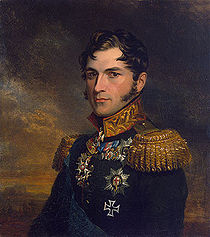Leopold I Belgium 1790 – 1865
January 21, 2009
 Leopold
I (Leopold George
Christian Frederick) Prince of Saxe Coburg and Gotha, Duke of
Saxony 1790 – 1865 was from 21 July 1831 the first King of the
Belgians. He was
the founder of the Belgian line of the House of Saxe Coburg
Gotha. His
children included Leopold II of
Belgium and
Empress Carlota of
Mexico.
Leopold
I (Leopold George
Christian Frederick) Prince of Saxe Coburg and Gotha, Duke of
Saxony 1790 – 1865 was from 21 July 1831 the first King of the
Belgians. He was
the founder of the Belgian line of the House of Saxe Coburg
Gotha. His
children included Leopold II of
Belgium and
Empress Carlota of
Mexico.
Leopold was the uncle of Prince Albert and Queen Victoria.
Leopold was a patient of Frederick Hervey Foster Quin (_Hahnemann: His Life & Times. _M. Trevor Cook, Stuart Close. B. Jain Publishers, 2001. Page 144 Onwards. See also _Southwestern Homeopathic Journal and Review, Volumes 2-3.** _1848. Page 118 onwards. And _Quarterly Homeopathic Journal, Volume 1.** _Otis Clapp, 1849. Page 131), Baron Louis Joseph G Seutin, and Leopold knew Samuel Hahnemann well.
Leopold was the youngest son of Franz Frederick Anton, Duke of Saxe Coburg Saalfeld and Countess Augusta Reuss Ebersdorf, and later became a prince of Saxe Coburg and Gotha after the territorial swap by his father of Ehrenburg Castle in the Bavarian town of Coburg. He was also an uncle of Queen Victoria of the United Kingdom.
In 1795, as a mere child, Leopold was appointed colonel of the Izmaylovsky Imperial Regiment in Russia. Seven years later he became a major general. When Napoleonic troops occupied the Duchy of Saxe Coburg in 1806 Leopold went to Paris.
Napoleon Bonaparte offered him the position of adjutant, but he refused. Instead he took up a military career in the Imperial Russian cavalry. He campaigned against Napoleon, and distinguished himself at the Battle of Kulm at the head of his cuirassier division. In 1815, Leopold reached the rank of lieutenant general in the Imperial Russian Army.
In Carlton House on 2 May 1816, he married Princess Charlotte Augusta of Wales, the only legitimate child of the British Prince Regent (later King George IV of the United Kingdom) and therefore heiress to the British throne, and was created a British field marshal and Knight of the Garter.
On 5 November 1817, Princess Charlotte was delivered of a stillborn son; she herself died the following day. Had she lived, she would have become Queen of the United Kingdom on the death of her father, and Leopold presumably would have assumed the role later taken by his nephew, Prince Albert, as Prince Consort of Great Britain, and never chosen King of the Belgians.
Despite Charlotte’s death, the Prince Regent granted Prince Leopold the British style of Royal Highness by Order in Council on 6 April
- In honor of his first wife, Leopold and Louise Marie of France, his second wife, named their first daughter Charlotte, who would later become Empress Carlota of Mexico.
On 2 July 1829, Leopold participated in nuptials of doubtful validity (a private marriage contract with no religious or public ceremony) with the actress Caroline Bauer, created Countess of Montgomery, a cousin of his advisor, Christian Friedrich Freiherr von Stockmar.
The ‘marriage’ reportedly ended in 1831 and the following year he married Louise Marie of France at the Château de Compiègne, in Compiègne, France, on 9 August 1832.
After Belgium asserted its independence from the Netherlands on 4 October 1830, the Belgian National Congress, considered several candidates and eventually asked Leopold to become king of the newly formed country. He was elected on 4 June and accepted and became “King of the Belgians” on 26 June 1831. He swore allegiance to the constitution in front of the Saint Jacob’s Church at Coudenbergh Place in Brussels on 21 July 1831. This day became the Belgian national holiday. Jules Van Praet would become his personal secretary.
Less than two weeks later, on 2 August, the Netherlands invaded Belgium. Skirmishes continued for eight years, but in 1839 the two countries signed the Treaty of London establishing Belgium’s independence.
With the opening of the railway line between Brussels and Mechelen on 5 May 1835, one of King Leopold’s fondest hopes—to build the first railway in continental Europe—became a reality.
In 1840, Leopold arranged the marriage of his niece, Queen Victoria, the daughter of his sister, Princess Victoria of Saxe Coburg-Saalfeld, to his nephew, Prince Albert, son of his brother, Ernst I, Duke of Saxe Coburg and Gotha. Even before Queen Victoria succeeded to the throne, Leopold had been advising her by letter, and after her accession, he was one of the great influences on her in the early days of her monarchy.
In 1842, Leopold tried unsuccessfully to pass laws to regulate female and child labor. A wave of revolutions passed over Europe after the deposition of Louis Philippe from the French throne in 1848. Belgium remained neutral, mainly because of Leopold’s diplomatic efforts.
He was the 649th Knight of the Order of the Garter in 1816, the 947th Knight of the Order of the Golden Fleece in Spain in 1835 and the 35th Grand Cross of the Order of the Tower and Sword.
On 11 October 1850, Leopold again lost a young wife, as Queen Louise Marie of France died of tuberculosis at age 38.
At 11:45 am on 10 December 1865, the king died in Laken. He lies buried in the Royal vault at the Church of Our Lady, Laken Cemetery, Brussels, Belgium.